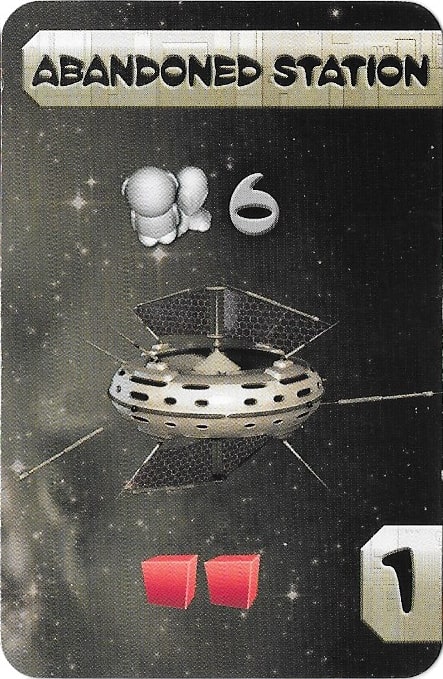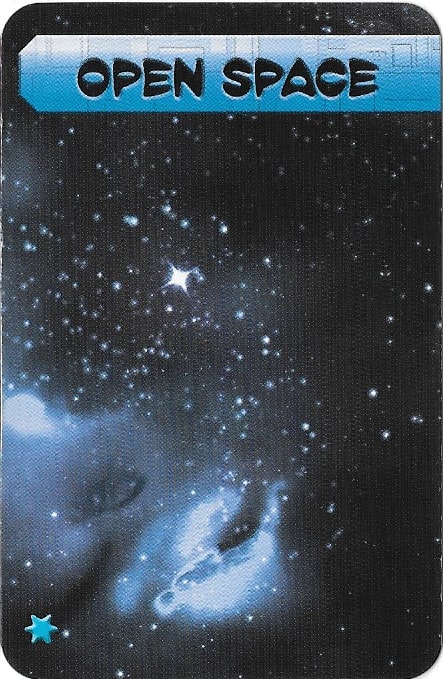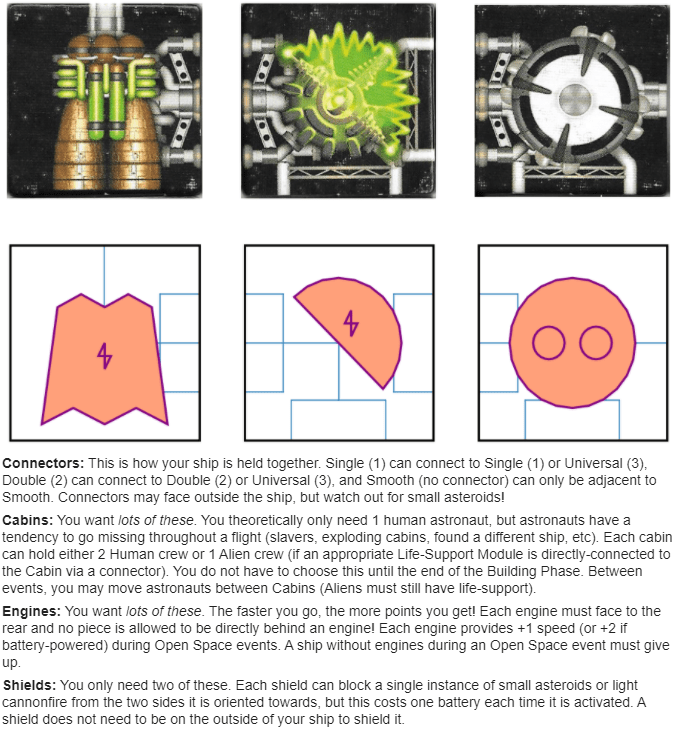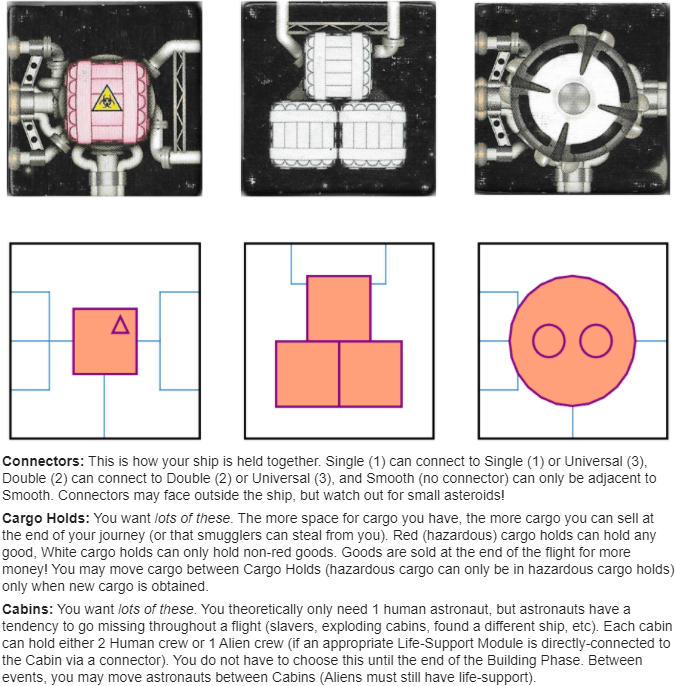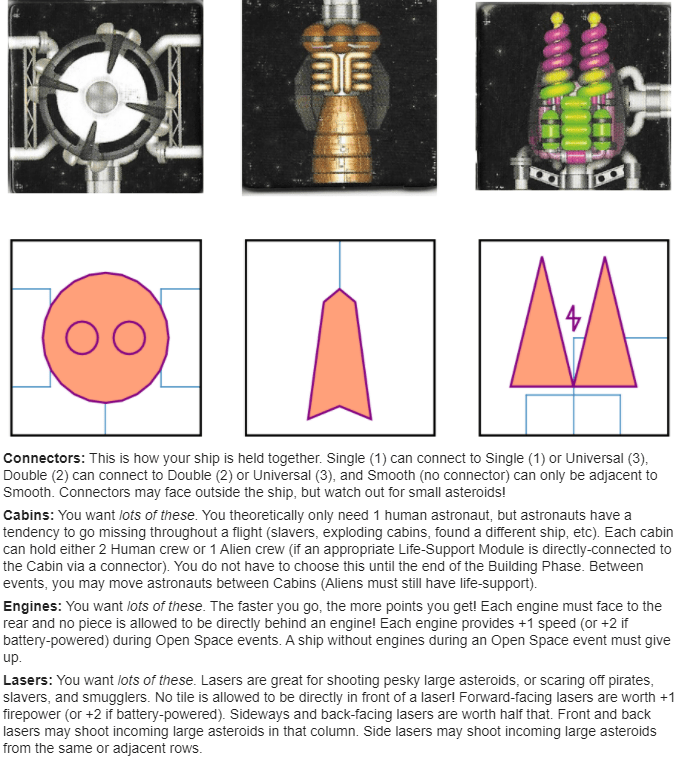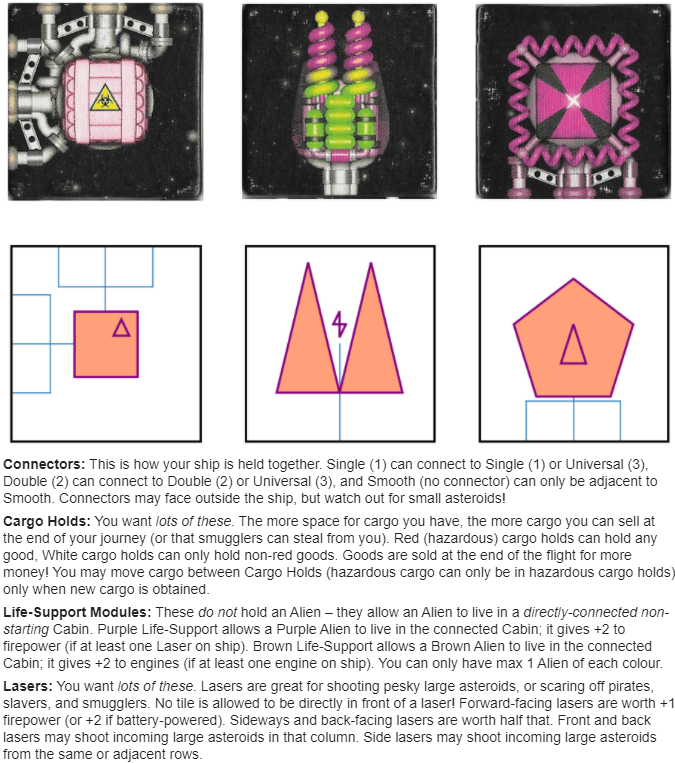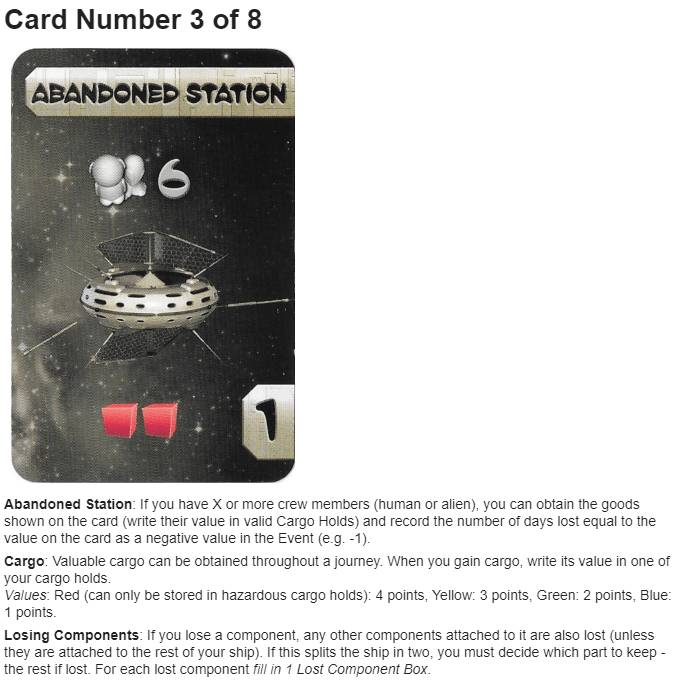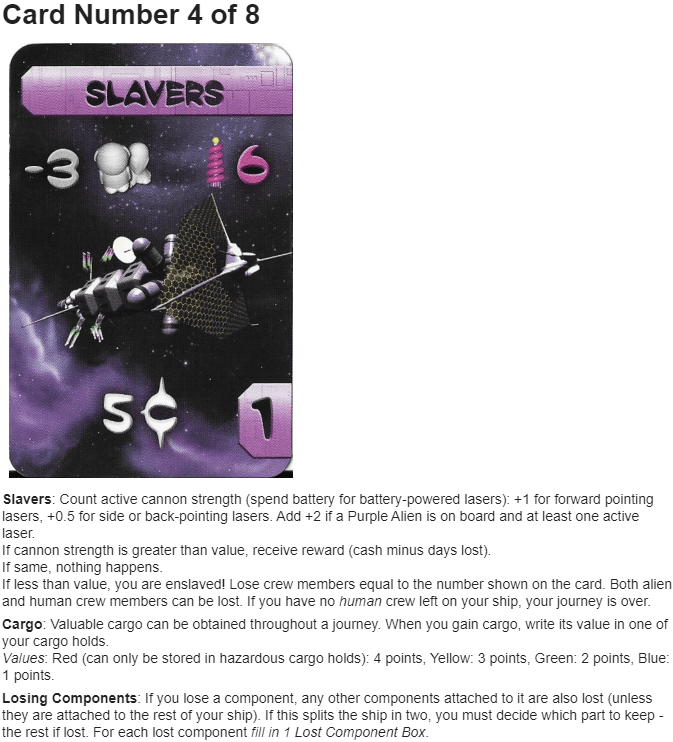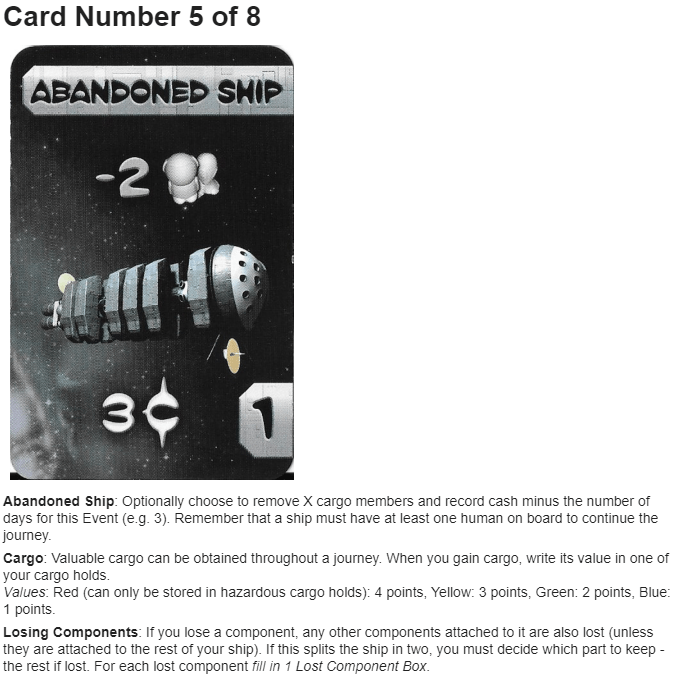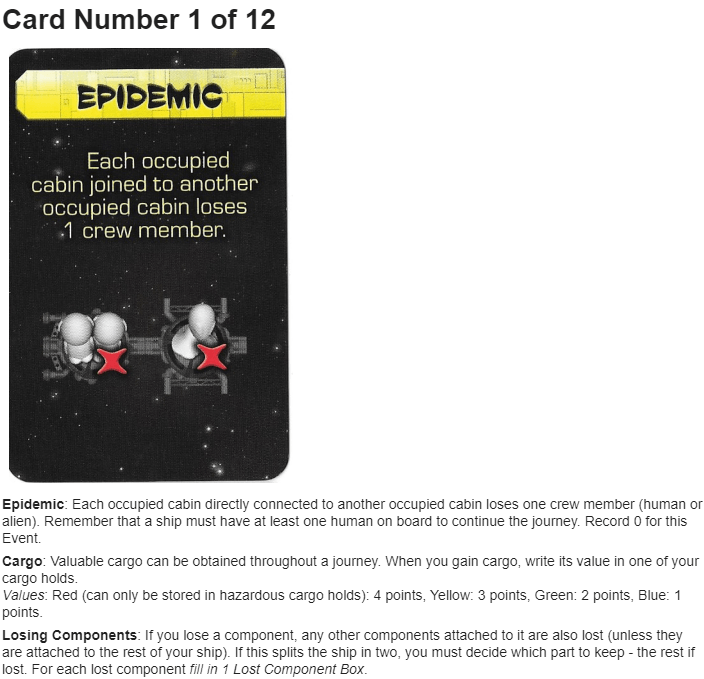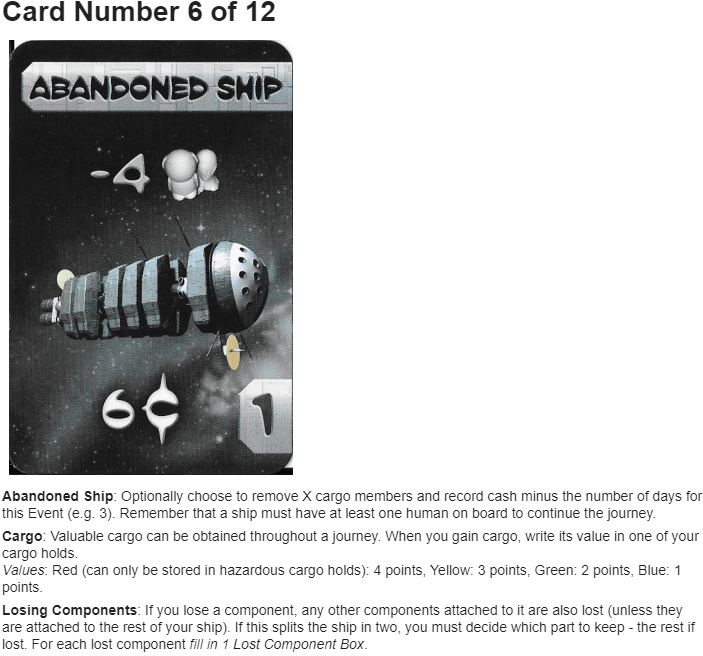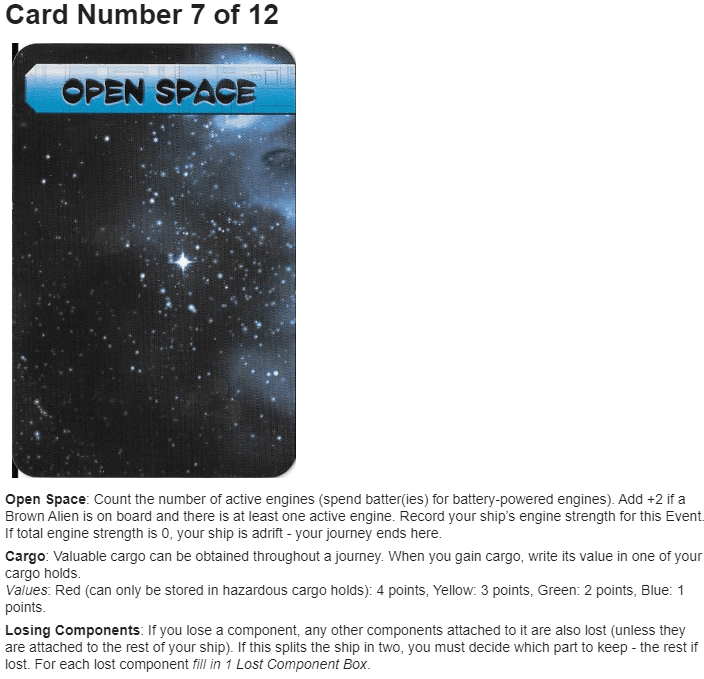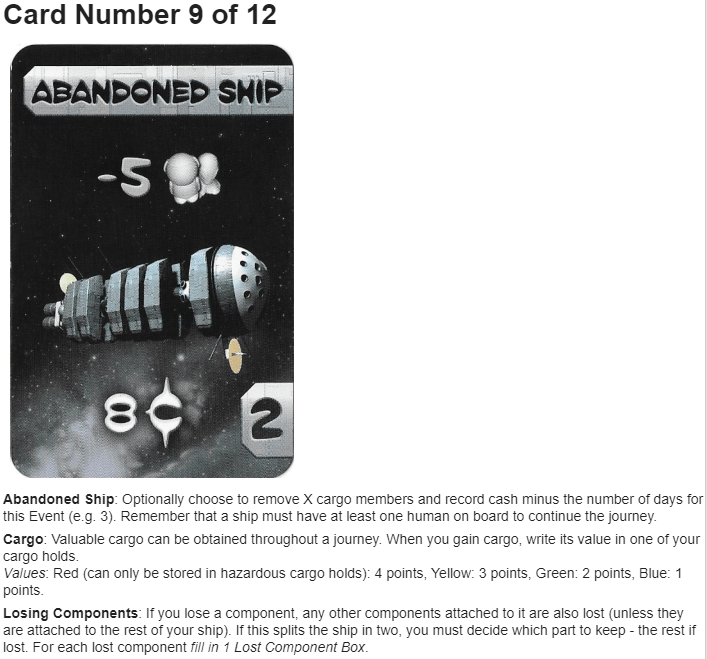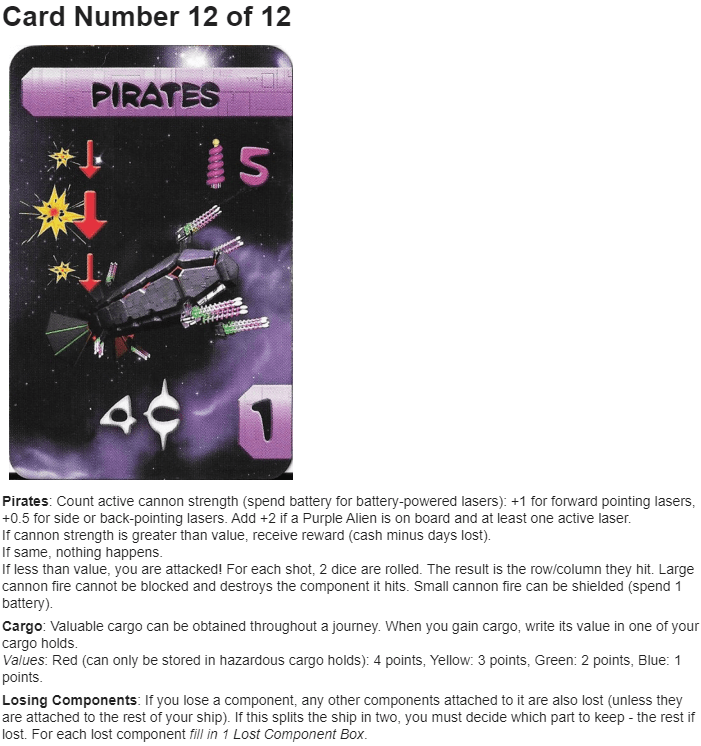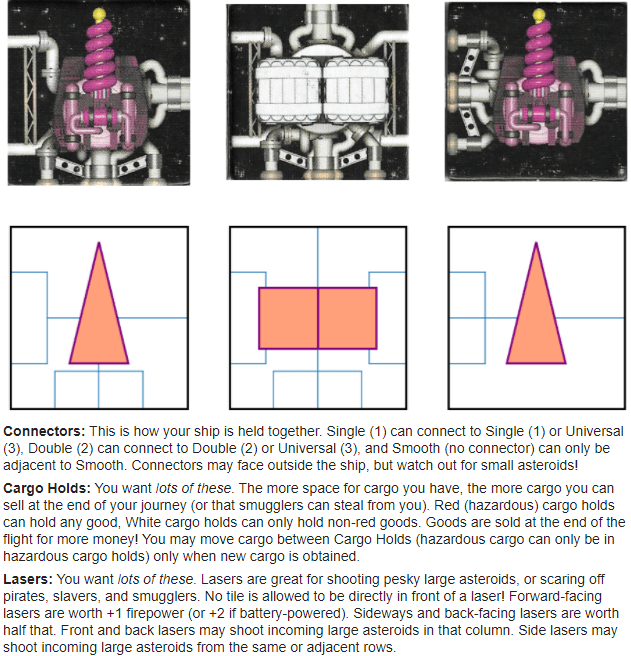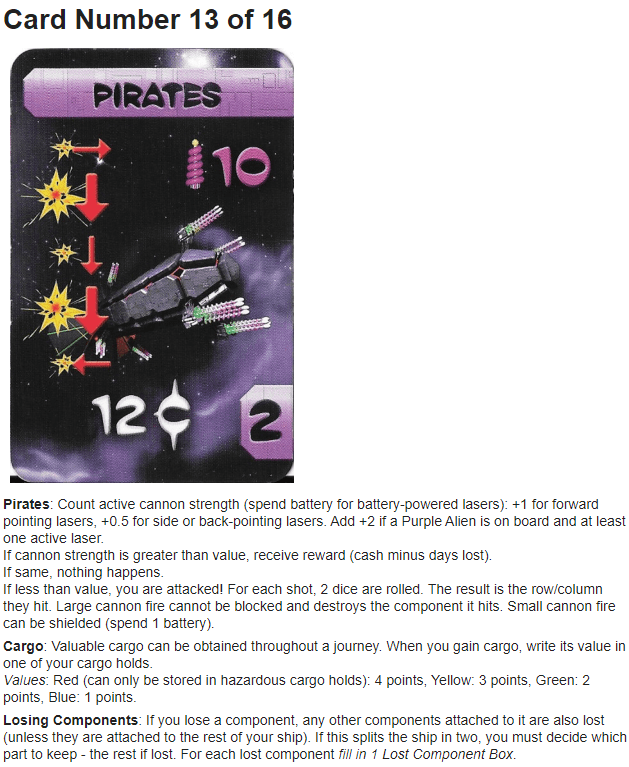The Daily Board: Galaxy Trucker Roll’n’Write
Boy, these coronatimes suck for board gaming, don’t they? Maintaining that 1.5m distance rules out most games, not to mention the regular mingling of people at our monthly events. We’ll be back one day!
But for now, we’ve got a small something to help pass the time. Way back in March, when the NZ lockdown was in full-swing, one of my old gaming conventions ‘Board Games by the Bay’ had the neat idea to play Welcome To… as a play-by-post over Facebook. Every day, the host of the game would flip three cards, and everyone would write in their respective choices on their sheets at home, with light communication to indicate when a goal was achieved, and when the game was over. I figured we could do the same thing! But then I figured out it was a lot of taking photos and writing rules.
Later, when infection rates were relatively low, we at Wageningen Board Gamers hosted a Physically-Distant Board Game Meetup on the 6th September, 2020. While nowhere near as popular as our regular events, and much more awkward, the event was a success, with a number of games being played (including roll’n’writes).
But I wasn’t satisfied with playing a regular roll’n’write game at that event – I wanted my all-time favourite game Galaxy Trucker as a roll’n’write! Breaking it down into a turn-based, non-interactive game wasn’t too difficult – some cards needed to be removed, and some rules altered, but ultimately, the game worked! If you already know how to play Galaxy Trucker, then playing this roll-n-write version also works. And even better: it works just like Welcome To… does for a daily play-by-post.
So without further ado: I present the rules for The Daily Board: The Unofficial Galaxy Trucker Roll’n’Write. For the month of October (and probably a bit beyond), WBG will be posting options for playing the game one turn at a time. It doesn’t matter if you fall behind, or start late. Simply catch up by going through the posts one-by-one, either on Facebook, Discord, or the bottom of this article (updated weekly). You’re on the honesty system, so no cheating! At the end of it all, we’ll see who wins!
Galaxy Trucker Roll’n’Write Rules
Disclaimer: Galaxy Trucker Roll’n’Write rules were developed by Sam Sarjant using the Galaxy Trucker base game as source material for core rules, tile images, and card images. This work is NOT FOR SALE. This unofficial variant is not authorised, licensed, approved, or endorsed by Czech Games Edition or Vlaada Chvátil. Galaxy Trucker and all card and tile images are property of Czech Games Edition.
Galaxy Trucker Roll’n’Write is a game about building a ship from sewer pipes and junk, flying that ship across dangerous space, where asteroids, pirates, and planets lurk, then making money based on the flight, losing money for every component lost on the trip.
Those who already know Galaxy Trucker should still read these rules, as they differ from the normal board game in some areas. Importantly, cash and movement of days on the racetrack are equivalent in this version. Also, during the Building Phase, it is not possible to look at the upcoming cards of the Flying Phase.
Instructions will be included with each post of how to resolve each card, as well as instructions for how to perform steps in between phases. You can also ask about rules at any time – without the regular time pressure of Galaxy Trucker, asking about rules is much easier.
Game Overview
Galaxy Trucker Roll’n’Write is played over three rounds, where each round is split into three phases: Building, Flying, and Scoring. For rounds 1/2/3, the Building Phase consists of 8/11/14 turns, followed by 4/6/8 Flying Phase turns (a total of 51 turns in the entire game). After all three rounds are complete, the game is over and the winner is the player(s) who earned the most money. The Play-By-Post nature of this game means that two turns will happen each day: one in the morning, and one in the afternoon, hence the game will take 26 days to complete.
The Building Phase consists of multiple turns, where each turn you are presented with 3 sets of 3 tiles each (see Tile Types for a list of tiles that could be available). Two turns occur each day until the maximum number of turns for that round are met (8/11/14 turns per round 1/2/3). Starting with the first set, you must select one tile (and ONLY one tile) from that set to add to your ship, or skip that set. If you select a tile, it must be placed legally (see rules for tile placement in Tile Types) in one of the allocated locations for that ship, and each tile must connect to another tile. Instead, if you skip the set, you must mark one of your Skipped Parts boxes on your ship (see Printouts); this will count as negative points for this round. Continue taking turns, selecting (or skipping) sets until you are satisfied with your ship and wish to pass the rest of the Building Phase. Once you have passed, you cannot add any further tiles to your ship.
During the Building Phase, you can also look at one of the three piles of upcoming event cards for the Flying Phase. After at least one tile has been added to your ship, you can choose to look at 2/3/4 (for rounds 1/2/3) upcoming cards in the Flying Phase by marking one of your Skipped Part boxes each time you look at a pile. This does not mean you skip selecting a tile – just that you mark a box. This action can be useful for determining what sorts of event cards are coming up. The links for doing this action will always be available, so please be honest and mark a Skipped Part box if you look at a pile.
Once the maximum number of turns have occurred (8/11/14 for rounds 1/2/3), the Building Phase is complete. Now, each player will need to:
- Check that all tiles are legally placed. Any illegal placements must be removed, counting as a Lost Component for the ship (fill in a Lost Component box). This means all tile connectors must be legal, and all lasers and engines have nothing in front or behind them respectively. Also, all engine tiles must face down.
- Fill in their crew Cabins with either two humans or one alien of the appropriate colour, if an appropriate Life Support Module is attached to the cabin. Only one alien of each colour may be on the ship. Denote the occupant of each cabin space with either ‘H’ (human), ‘L’ (laser alien), or ‘E’ (engine alien); remember that cabins containing an alien can only hold one alien, so colour out the other cabin space. Whenever a crew member leaves a cabin, colour out that space to show they are no longer present.
- Enter the number of Skipped Parts in the Starting Position field (multiplied by -2).
The Flying Phase consists of several cards (8/12/16 for round 1/2/3), with two cards presented each turn (see list of possible cards in Event Cards). Starting with the first card, you must resolve each card fully. If a card requires dice rolls, these will be provided with the card, though they will be obscured so the results are not immediately known (honesty system again!). Each card describes how to resolve it – write down the total profit/loss in points received for that card in the respective Event box. During a flight, components may fall off your ship. When this happens, cross out the component on the ship and fill in a Lost Components box (these are limited to a maximum – thanks insurance!). Each lost component is worth -2 points at the end of the round.
If your ship ever has 0 human astronauts left on it, you are out of the round. In this case, sell all cargo at half price (sum all cargo values then half it, rounding up), and use value 0 for all remaining events and the total for the Pretty Ship.
If a component on your ship is ever removed that results in your ship breaking into two or more chunks, you must select which chunk you will continue with. All components on the other chunk are lost (fill in Lost Component boxes). Remember, you must always have at least 1 human astronaut on board your ship (aliens just go home if left without supervision).
After the Flying Phase is complete, the score for the round is calculated:
- Calculate how pretty your ship is by counting the number of exposed connectors and subtracting it from this journey’s Pretty Ship value. Record this in the ‘Pretty Ship Value’ box.
- Sum all of your cargo and record it in the ‘Total Cargo Value’ box.
- For each filled box in Lost Components, lose 2 points and record in ‘Lost Component Value’ box.
- Add all values together (Position + Events + Cargo + Lost Components + Pretty Ship). This is your score for this round!
If it is Round 1 or Round 2, get ready for the next round by printing out the next ship for the round. Otherwise, add up all your points from all rounds and that is your total score. Post in the comments what score you got! We’ll collect everyone’s score and post the rankings.
Tile Types
During the Building Phase, you will have access to numerous tile types. Each tile has one or more connectors which allow it to connect to the rest of your ship. During building, every newly added tile must legally connect to the rest of your ship (initially, only the central Cabin tile). When placing a tile, you can rotate it however you like, but not mirror it. Some tiles (lasers and engines) have special rules about how they can be placed, and all tiles must follow the connector rules.
Each tile is shown with both the regular game art, and suggested simplified art for adding it to your ship. You may add them how you wish, as long as their function is clear to you.
Connectors: This is how your ship is held together. Single (1) can connect to Single (1) or Universal (3), Double (2) can connect to Double (2) or Universal (3), and Smooth (no connector) can only be adjacent to Smooth. Connectors may face outside the ship, but watch out for small asteroids!
Batteries: You only need batteries if you have battery-powered lasers, engines, or any shield(s). Each battery can only be used once. When a battery is used, colour out the battery component. Batteries do not have to be directly adjacent to the component they are powering.
Cargo Holds: You want lots of these. The more space for cargo you have, the more cargo you can sell at the end of your journey (or that smugglers can steal from you). Red (hazardous) cargo holds can hold any good, White cargo holds can only hold non-red goods. Goods are sold at the end of the flight for more money! You may move cargo between Cargo Holds (hazardous cargo can only be in hazardous cargo holds) only when new cargo is obtained.
Cabins: You want lots of these. You theoretically only need 1 human astronaut, but astronauts have a tendency to go missing throughout a flight (slavers, exploding cabins, found a different ship, etc). Each cabin can hold either 2 Human crew or 1 Alien crew (if an appropriate Life-Support Module is directly-connected to the Cabin via a connector). You do not have to choose this until the end of the Building Phase. Between events, you may move astronauts between Cabins (Aliens must still have life-support).
Engines: You want lots of these. The faster you go, the more points you get! Each engine must face to the rear and no piece is allowed to be directly behind an engine! Each engine provides +1 speed (or +2 if battery-powered) during Open Space events. A ship without engines during an Open Space event must give up.
Lasers: You want lots of these. Lasers are great for shooting pesky large asteroids, or scaring off pirates, slavers, and smugglers. No tile is allowed to be directly in front of a laser! Forward-facing lasers are worth +1 firepower (or +2 if battery-powered). Sideways and back-facing lasers are worth half that. Front and back lasers may shoot incoming large asteroids in that column. Side lasers may shoot incoming large asteroids from the same or adjacent rows.
Life-Support Modules: These do not hold an Alien – they allow an Alien to live in a directly-connected non-starting Cabin. Purple Life-Support allows a Purple Alien to live in the connected Cabin; it gives +2 to firepower (if at least one Laser on ship). Brown Life-Support allows a Brown Alien to live in the connected Cabin; it gives +2 to engines (if at least one engine on ship). You can only have max 1 Alien of each colour.
Shields: You only need two of these. Each shield can block a single instance of small asteroids or light cannonfire from the two sides it is oriented towards, but this costs one battery each time it is activated. A shield does not need to be on the outside of your ship to shield it.
Structural Modules: These do not do anything in particular. But they can be handy for linking up your ship.
Event Cards
During the Flying Phase, each ship in the round will be subjected to the same 8/12/16 cards for rounds 1/2/3. Round 1 includes 8 level 1 cards, Round 2 includes 8 level 2 cards and 4 level 1 cards, and round 3 includes 8 level 3 cards, 4 levels 2 cards, and 4 level 1 cards. Cards are randomly sampled, but are the same for all players. During the Building Phase, players may have looked at up to 6/8/12 of the cards for this phase – these cards are guaranteed to be in the flight, but the order is randomised.
One-by-one, each ship resolves each event card. If a card includes dice rolls, those rolls will be provided (in obscured format so it is not known what they are beforehand). After each card, record the total points gained/lost for that event.
Cargo: Valuable cargo can be obtained throughout a journey. When you gain cargo, write its value in one of your cargo holds.
Red (can only be stored in hazardous cargo holds): 4 points,
Yellow: 3 points,
Green: 2 points,
Blue: 1 point.
Losing Components: If you lose a component, any other components attached to it are also lost (unless they are attached to the rest of your ship). If this splits the ship in two, you must decide which part to keep – the rest if lost. For each lost component fill in 1 Lost Component Box.
Abandoned Ship: Optionally choose to remove X cargo members and record cash minus the number of days for this Event (e.g. 3). Remember that a ship must have at least one human on board to continue the journey.
Abandoned Station: If you have X or more crew members (human or alien), you can obtain the goods shown on the card (write their value in valid Cargo Holds) and record the number of days lost equal to the value on the card as a negative value in the Event (e.g. -1).
Open Space: Count the number of active engines (spend batter(ies) for battery-powered engines). Add +2 if a Brown Alien is on board and there is at least one active engine. Record your ship’s engine strength for this Event. If total engine strength is 0, your ship is adrift – your journey ends here.
Planets: Optionally select a planet to land on and receive those goods. Record the number of days lost as a negative value in the Event (e.g. -3). Red cargo can only be stored in hazardous cargo hold. All other cargo can be stored in any cargo hold. Write down the value of the cargo in the hold. Existing cargo can be replaced by new cargo. Cargo can only be moved around when new cargo is obtained.
Stardust: Count the number of exposed connections (Single, Double, and Universal all count as 1). Record the number of days lost as a negative value in the Event (e.g. -3).
Epidemic: Each occupied cabin directly connected to another occupied cabin loses one crew member (human or alien). Remember that a ship must have at least one human on board to continue the journey. Record 0 for this Event.
Meteoric Swarm: For each meteor, two dice are rolled. The result is the row/column they hit. Large meteors can be shot by cannons in the same column (if column), or adjacent row (if row). Small meteors bounce off harmlessly if there are no exposed connectors. Small meteors can also be shielded by a shield facing the appropriate direction (spend 1 battery). Any components damaged are destroyed (cross them out and mark 1 Lost Components box). Record 0 for this Event.
Pirates/Slavers/Smugglers: Count active cannon strength (spend battery for battery-powered lasers): +1 for forward pointing lasers (+2 for battery-lasers), +0.5 for side or back-pointing lasers (+1 for battery-lasers). Add +2 if a Purple Alien is on board and at least one active laser.
If cannon strength is greater than value, receive reward of cash/cargo, but subtract the number of days lost.
If the same, nothing happens.
If less than value, you are attacked!
Pirates: For each shot, 2 dice are rolled. The result is the row/column they hit. Large cannon fire cannot be blocked and destroys the component it hits. Small cannon fire can be shielded (spend 1 battery).
Slavers: Lose crew members equal to the number shown on the card. Both alien and human crew members can be lost. If you have no human crew left on your ship, your journey is over.
Smugglers: Lose cargo equal to the number shown, losing most valuable cargo first. If you have no cargo, lose batteries instead. If you have neither, the smugglers make fun of you and leave without taking anything.
After the flight is complete, calculate the score for this round using the scoring procedure defined in Game Overview.
Printouts
Printouts for ships for Round 1, 2, and 3 can be found here.



Weekly Post Summary
This section of the article will be updated approximately weekly with the daily posts. Feel free to use it to catch up on posts you missed, or to start a whole new ship!
Round 1
During the Building Phase, after placing at least one tile onto your ship, you may look at a stack by marking in one Skipped Parts box (this does not skip a tile choice). This can be performed as well as picking/skipping a tile. Each stack can be seen here (each stack=1 Skipped Part box): Stack 1, Stack 2, Stack 3.
Building Phase
From left-to-right, top-to-bottom, resolve each set of 3 tiles by selecting one, or skipping that set (marking Skipped Parts).
Flying Phase
From left-to-right, top-to-bottom, reoslve each event card. In the case where dice rolls are needed, they have been provided.
Round 2
During the Building Phase, after placing at least one tile onto your ship, you may look at a stack by marking in one Skipped Parts box (this does not skip a tile choice). This can be performed as well as picking/skipping a tile. Each stack can be seen here (each stack=1 Skipped Part box): Stack 1, Stack 2, Stack 3.
Building Phase
From left-to-right, top-to-bottom, resolve each set of 3 tiles by selecting one, or skipping that set (marking Skipped Parts).
Flying Phase
From left-to-right, top-to-bottom, resolve each event card. In the case where dice rolls are needed, they have been provided.
Round 3
During the Building Phase, after placing at least one tile onto your ship, you may look at a stack by marking in one Skipped Parts box (this does not skip a tile choice). This can be performed as well as picking/skipping a tile. Each stack can be seen here (each stack=1 Skipped Part box): Stack 1, Stack 2, Stack 3.
Flying Phase
From left-to-right, top-to-bottom, resolve each event card. In the case where dice rolls are needed, they have been provided.











